UK Parrot Society sponsored artificial nest boxes for parrots in Australia
Following the success of the 'tree tinning' project, we announced in September 2018 that ongoing financial support from the Parrot Society's Conservation fund has allowed Ray Ackroyd to produce a batch of artificial nest boxes to increase potential cockatoo nesting sites. Following disastrous fires and prolonged drought in 2017 and 2018, many existing trees have disappeared.
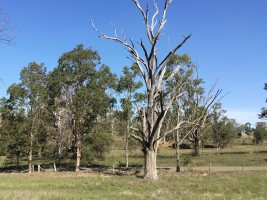
A dead tree, which could provide one or at most two nest sites for cockatoos
Ray has constructed nest boxes from dead trees, thereby creating dozens of potential sites from one tree, that left standing would house no more than two pairs of birds -
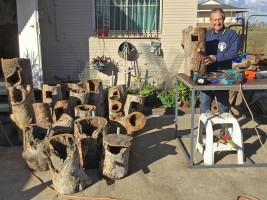
- as well as making 'conventional' artificial boxes from sawn timber -
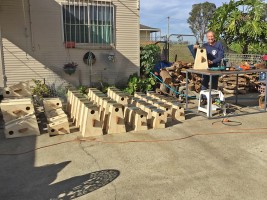
Ray tells us that the unusual (to British eyes) A-frame shape of the boxes is to reduce the amount of roof that exposed to the sun. An important consideration when temperatures regularly reach 40 degrees C or more! With these birds' breeding season fast approaching, Ray is working hard to get these boxes distributed and mounted.
November 2018 Update: Ray reports that more than 50% of the nest boxes that have been sited and mounted are already occupied by Cockatoos and other parrot species, an excellent result! He says in a message to the Parrot Society that "No doubt with all the land clearing they were fairly desperate to get a nesting site. Thanks again to PSUK for allowing that to happen".
May 2019 Update: Ray reports that "There can be no dispute that the funding by the Parrot Society UK to construct nesting boxes for the above species, considering that their original old growth nesting trees have been destroyed, is money well spent and is working very well as the pictures clearly indicate. A lot of the local old growth trees have been bulldozed down to make way for housing development in South West Sydney."
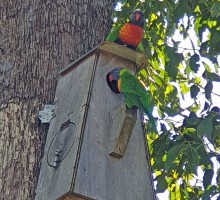
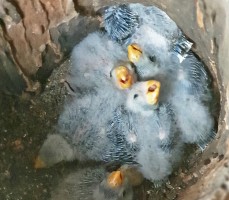
Rainbow (Swainson's) Lorikeets checking out a nest box; Chicks in a box
"The PS nestbox project is isolated away from any other so called nest box programmes here that other organisations are trying. Quite frankly ours work - theirs don't and the reason is that their field knowledge doesn't guide them to erect them in the correct places. Our boxes are busy at all times and the pairs continually come back to check out their nest sites. I continually have problems with Indian Mynahs and starlings and unfortunately for them I have to net and destroy them. That is legal here for those pest birds".
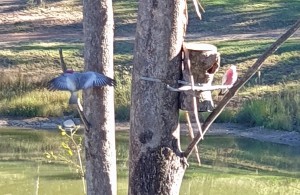
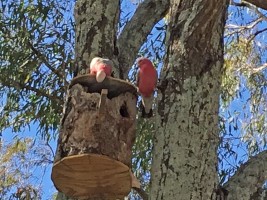
Galah's (Roseate Cockatoos) checking out nest boxes
January 2020 Update: Following the disastrous bush fires and extensive loss of habitat and wildlife that we have all been watching on our TVs, we sent a message to Ray Ackroyd asking how thins were, and if there was anything more we could do to help. This was his reply -
"I really don’t think anybody can envisage the loss of wildlife. You are certainly correct when you say it will take many years to recover. The first thing that fire enjoys is hollow trees and hollow branches. There will be concern in relation to Swift Parrots who migrate up to our South Coast during our Autumn to feed on Nectar, Pollen and Lerps from the very trees that are now severely burned. This year's fires may have a massive impact as to the future of the limited wild population of Swifts.
Apart from the fires and smoke the summer temperature here has been extremely hot. Most of the days from Christmas onwards have been in the 40s. The 4th of January along the Coast was excessively warm with Western Sydney getting a reading of 49.5c. Aviculture has had some big losses and outer Sydney Poultry Farms had substantial losses.
I have been talking to a number of Bird Societies and they have already put the wheels in motion regarding erecting nest boxes in areas affected by fire. These Societies are now in talks with Government Departments and will no doubt receive funds to support the cost of constructing nest boxes of various sizes. These will undoubtedly follow the pattern that was set by the PSUK when you funded me to implement the nest box programme for parrots under the stress of losing their breeding trees.
No doubt they will erect the boxes in areas around the towns ie:- Golf Courses, Reserves and School Grounds where they can be monitored. It’s a big job, but it can be done.
The Societies work with The Men’s Sheds and they are a group of dedicated retirees who enjoy doing work such as carpentry for Charity. Certainly these men get a lot of personal satisfaction assisting those in need of help. The local Men’s Shed have already constructed some 500 boxes. I have already donated a lot of material for the construction of those boxes.
On behalf of the Australian people I would like to thank the Council and the members of the PS UK for their concern for our wild bird populations due to the ongoing fires. There is already substantial funding forthcoming to our Bird Societies, however I will let it be known particularly to our NSW Avicultural Society of your concern and offer to assist.
No doubt you will want to be continually advised on the programme and I will do that for you.
Kind Regards to all.
Ray attached a couple of photographs of nest boxes being constructed by the 'Men's Sheds' group -
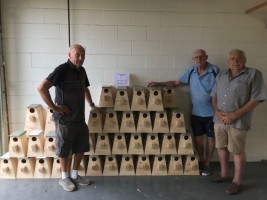
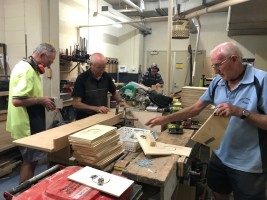
February 2020 Update:
I am now happy to report that our entire South Coast is receiving some very heavy rain, in fact some flooding is imminent. On the upside that will generate an immediate recovery for the regeneration of the Eucalyptus Forests and the undergrowth of plants that go along with that. On the downside there will undoubtedly be a huge wash of Ash into the water catchments and that can create havoc with a great deal of Marine Life.
As you are aware I did spend time down in the fire region. I also spent a lot of hours walking the forest floor and speaking with a lot of the local people. Quite frankly I've done it all before and undoubtedly I'll do it all again, that is until our Government Authorities wake up and implement the correct management techniques in relation to fire within Eucalyptus Forests.
My major concern in respect to this coastal fire was of course the welfare of the wild native birds within the fire region. Some academic researchers were stating that the loss of all wildlife was catastrophic, so needless to say I was concerned and needed to check it all out. I had previously spent some days up in the Southern Highlands and found that a great deal of the Gang-Gang Cockatoo nestlings had perished with heat and smoke from the fires in that region. Gang-Gang Cockatoos usually go to nest in late October and of course in early January they have advanced young in the nest. The parent birds have no alternative but to abandon their young. Fortunately not all the nest hollows were lost, however the mass of smoke and heat was just to much for the chicks to survive.
Anyway, I started my study from the Township of Nowra, then all the way south to Eden almost to the border of Victoria. That was the major Coastal fire Region. In essence this 2020 fire certainly was in no way as catastrophic as some of the fierce hot fires I have witnessed over the years and I will attach the details of the ferocity of those past fires and the loss of life and property to you. However, that is not to say that a lot of property, livestock and native animals, and in fact human lives suffered extensively during this January 2020 fire season.
In total I walked the forest floor in various regions, spending around 8 hours each day, covering a fair area. During that time I never found evidence of one single dead bird. My notes show that although there was some heavily burnt country, there were also many unburnt corridors adjacent. Past hot fires have shown me personally that native wildlife immediately take refuge within that unburnt habitat. There were also areas where because of lack of wind assistance, the fire fed almost exclusively on the ground fuel, resulting in a slow burn. So basically the tree canopy was untouched allowing for some tree-climbing animals to take refuge in the treetops.
So it wasn't all bad news and certainly not as catastrophic as I had been led to believe by some of the press releases. In respect to wild birds and fire, I have found that wild birds have that special built-in mechanism that prematurely tells them to move away from fire. However, it must be said that many nestling birds perish when fire attacks their nesting habitat at incubation time or when young are still in pin feather unable to leave the nest. That occurrence never happened down the coast this year as the spring nesting season for most birds had finished . The exception is the Gang-Gang Cockatoos, which are late nesting birds. On the other hand that species usually nests away from the coast so would be isolated away from the Coastal fire of 2020.
Some birds do remain during fire, and actually hunt the upsurge of insects forced into the atmosphere by the fire and heat below, and it is not unusual to observe thousands of raptors circling above the fire, in the smoke, gorging themselves on the abundance of high flying insects. Many other bird species immediately move back into hard burnt country as the floor then exposes a large variety of grass seeds, insects, fallen nuts and wild berries that they relish. During my 65 years in the north of Australia studying native birds during the dry season, where many hundreds of thousands of hectares are burnt annually as hazard reduction burns, I have taken particular notice of the reactions of wild native birds and fire. I have witnessed and photographed huge flocks of native finches returning to burnt out country even while their habitat was still smouldering. There are many other ground feeding birds that are attracted to burnt country ie:- Quail, Bustards, Coucals, native Doves and Pigeons that forage on the abundance of food that is exposed by fire.
There is a large range of native plants that are also adapted to regular fire and in particular coastal Banksia trees, flowering Grevillea and Hakea trees. These native trees, post fire, attract a very large range of Australian Native Birds including our large Black Cockatoos, various Lorikeets, Parrots, Honeyeaters and many others Nectar-eating native bird species. So indeed many Australian native bird species benefit from fire.
Over the years I have spent a lot of quality time with many native Aboriginals in various indigenous communities, and I have learned a great deal from them. Nothing has changed for them within their own environment. Even today, they still burn off country to attract bird and animal life that they hunt for food. That clearly reinforces my views that burnt country does in fact benefit and attract many species and the Indigenous aboriginals have been doing that since the "Bow and Arrow Days".
You may be interested as to how many bird nesting hollows were destroyed during the recent fires. Almost all the trees involved in the fire were Eucalyptus trees, and they are very resilient to fire. Naturally there were hollows lost in the very hot burn regions but in general I would have to say that all of the hollows in the upper canopy of the trees escaped any damage at all, and these are the hollows used by most Parrots. I checked a number of Glossy Black Cockatoo nesting sites south of the township of Nowra. These nests are in a Spotted Gum Forest that has burned out quite a few times over the past 50 years. Although to the average person it looked like a hot burn, it was in fact a slow burn and not one single nest was lost: in fact three nests were being inspected by the pairs that return to the same nesting site each year to breed.
So that was good news. I think that once the forest is opened up by fires it exposes nesting hollows that prior to the fire were in fact camouflaged by leaf matter, so in reality I would have to say that there are still many hollows available for birds and animals to nest and shelter right down the South Coast of NSW.
Just a few more things before I conclude. Some ecologists have recently stunned people by estimating that up to 1 billion animals perished in the recent South Coast Fires. I find that greatly exaggerated when in fact no study at all was conducted. Perhaps those statements are used to drum up funds for future research that seldom finishes. It was also stated that many species such as Koalas and Glossy Black Cockatoos could be extinct by as early as 2050. Both those species have a huge range in Australia and extinction is not going to happen. (Editors note: the Glossy Black Cockatoos present win Kangaroo Island are in fact the sub-species Calyptorhynchus lathami halmaturinus, which is NOT found on mainland Australia).
In respect to funding for the victims of this fire. I would have to say the Australian public are extremely generous when it comes to assisting those in need. To date, $AS 750 million have been donated to various organisations to distribute to the victims of the fires. History tells us that the poor souls suffering the force of that fire will only receive a small percentage of that funding. Also many other so-called carers put out their hands for funding and blag the community with absolutely no expertise. Our Government needs to address this issue as a matter of urgency, otherwise donations from all areas may in the future be extremely limited to assist those in need.
Finally, and I have mentioned this before: Over the years there have been 57 Government inquiries into fire management. These enquires entail - fire management practices, hazard reduction burns, well-maintained fire breaks (particularly in National Parks), and most importantly water storage to address fire prone regions. Despite the deaths of many people and the loss of millions of dollars-worth of property and livestock these Committees never conclude and they fail miserably to understand the basic principals of the management of our Environment and fire prevention techniques. Like my old man used to say, "Only fools ignore the lessons of the past ".
Well, that's about all I can outline for you re this fire. Unfortunately it is wide ranging and does take a bit of explaining. Over the next few days I will e-mail you further excerpts to add to this one.
My very best Regards to you, Sincerely Ray Ackroyd .
See also Tree Tinning In Australia
